
IC 64 is a massive lenticular galaxy located 622 million light-years away in the Pisces constellation. IC 64 has a diameter of 300,000 thousand light-years, making it, three times bigger than the Milky Way and one of the largest galaxies observed. IC 64 was discovered by Stephane Javelle, a French astronomer on 5th December, 1893. It has an active galactic nucleus and is considered a radio galaxy.
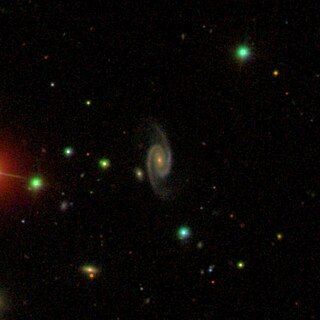
IC 3053 is a type Sab barred spiral galaxy with a ring located in the Coma Berenices constellation. The galaxy lies 720 million light-years from the solar system and has an estimated diameter of 180,000 light-years meaning the galaxy is much larger compared to the Milky Way. IC 3053 was first discovered by Royal Harwood Frost on May 7, 1904. Despite listed in the Virgo Cluster Catalogue as VCC 95, it is not a member of the Virgo Cluster due to its high redshift and instead a background galaxy.
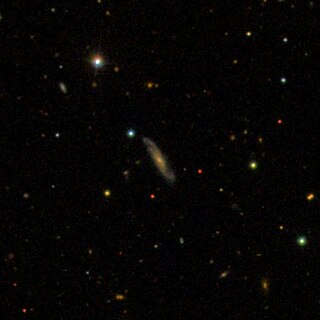
IC 3031 known as PGC 92941, is an edge-on spiral galaxy located in the Coma Berenices constellation. The galaxy lies 1.15 billion light-years away from the Solar System and has an estimated diameter of 240,000 light-years meaning it is bigger compared to the Milky Way. IC 3031 was discovered by astronomer Royal Harwood Frost on May 7, 1904.

IC 3246 known as PGC 40202, is a barred spiral galaxy with a ring located in the Virgo constellation. It is situated 1.13 billion light-years away from the Solar System and was discovered by Friedrich Karl Arnold Schwassmann on September 14, 1900. IC 3246 has a surface brightness of 23.6 magnitude/arc seconds and located at right ascension and declination respectively.

IC 3482 is a type Sb spiral galaxy in the Coma Berenices constellation. It is located 850 million light-years away from the Solar System. IC 3482 has an apparent size of 0.4 x 0.15 arcmin, meaning it has estimated diameter of 140,000 light-years. IC 3482 was discovered on March 23, 1903, by German astronomer pioneer, Max Wolf. It is located at right ascension of (12:33:01.00) and declination of (27:49:49:10), and has a surface brightness of magnitude 23.

IC 3786 is a type Sbc spiral galaxy in the Canes Venatici constellation. It is located 755 million light-years from the Milky Way and was discovered by Max Wolf on March 21, 1903.

IC 3789, occasionally known as PGC 1619535, is a type Sbc barred spiral galaxy in the Coma Berenices constellation. It is located 872 million light-years away from the Solar System and has an approximate diameter of 150,000 light-years making it slightly larger than the Milky Way. IC 3789 was discovered on 27 January 1904 by astronomer Max Wolf.
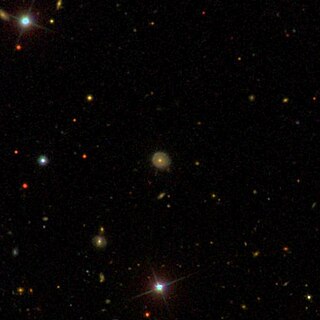
IC 4000 known as PGC 2152407, is a type Sbc spiral galaxy with a ring in the constellation of Canes Venatici. It is located 1.5 billion light-years away from the solar system and has an estimated diameter of 100,000 light-years which is the same length as the Milky Way. IC 4000 was discovered by Max Wolf on March 21, 1903. It has a surface brightness of 23.3 magnitude/arc seconds and located right ascension (12:59:36.62) and declination (39:35:15:90).

IC 2628 is a type SBa barred spiral galaxy with a ring located in Leo constellation. It is located 600 million light-years from the Solar System and has an approximate diameter of 135,000 light-years. IC 2628 was discovered on March 27, 1906, by Max Wolf and is classified as a ring galaxy due to its peculiar appearance. The galaxy has a surface brightness of magnitude 23.8 and located at right ascension (11:11:37.8) and declination (+12:07:21) respectively.

IC 535 known as PGC 26524 and PGC 1128295, is a type E elliptical galaxy with a ring located in the Hydra constellation. It is located 740 million light-years away from the Solar System and has an estimated diameter of 85,000 light-years. IC 535 was discovered on March 23, 1893, by Stephane Javelle. It has a surface brightness of 23.7 mag/arcsec and is moving at radial velocity of 16,049 kilometers per seconds. It is located at right ascension and declination.

IC 4537 is a type S0-a lenticular galaxy located in the Serpens constellation. It is located 736 million light-years from the Solar System and was found by astronomer Edward Emerson Barnard although the year of discovery was unknown. IC 4537 has a surface brightness of magnitude 23.9 and a right ascension of and declination. IC 4537 is apparently located a few miles away from the globular cluster, Messier 5.

IC 1166 are a pair of galaxies in the Corona Borealis constellation comprising IC 1166 NED01 and IC 1166 NED02. They are located 977 million light-years from the solar system and were discovered on July 28, 1892, by Stephane Javelle.
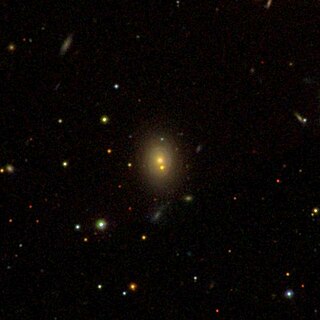
IC 1185 is a type Sab spiral galaxy located in Hercules. It is located 420 million light-years from the Solar System and has an approximate diameter of 115,000 light-years. IC 1185 was discovered on June 8, 1888, by astronomer Guillaume Bigourdan and is a member of the Hercules Cluster. IC 1185 has a surface brightness of magnitude 22.7 and presents a double nucleus, which might represent a late stage of galaxy merger.

NGC 3750 is a lenticular galaxy with a bar located in the constellation of Leo. It is located 450 million light-years from the Solar System and was discovered by Ralph Copeland on February 9, 1874.

NGC 3751 is a type E-S0 lenticular galaxy located in the Leo constellation. It is located 450 million light-years away from the Solar System and was discovered by Ralph Copeland on April 5, 1874.
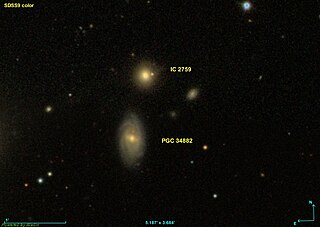
IC 2759 is a small type E elliptical galaxy located in the constellation of Leo. It is located 350 million light-years away from the Solar System and was discovered on April 24, 1897, by Guillaume Bigourdan. Sometimes IC 2759 is confused with the spiral galaxy, PGC 34882 which is located south of the galaxy.

IC 2816 known as PGC 3472124, is a type Sbc spiral galaxy with a ring structure located in the Leo constellation. It is located 878 million light-years from the Solar System and has apparent dimensions of 0.59 x 0.22 arcmin, meaning its diameter is 160,000 light-years across.

IC 3683 known as PGC 1637726, is a barred spiral galaxy with a ring structure located in Coma Berenices. It is located 853 million light-years from the Solar System and has an apparent dimension of 0.30 x 0.2 arcmin. IC 3683 was discovered by Max Wolf on January 27, 1904.

IC 2839, known as PGC 3472295, is a spiral galaxy located in the constellation Leo. Its redshift is 0.065734, which corresponds to the galaxy being located 906 million light-years from Earth. IC 2839 has an apparent dimension of 0.30 x 0.1 arcmin, meaning it spans 79,000 light-years across. The galaxy was discovered on March 27, 1906, by Max Wolf.
IC 2657 is a type E elliptical galaxy located in the constellation Leo. Its redshift is 0.167816, which means IC 2657 is 2.22 billion light-years away. IC 2657 is the second most distant Index Catalogue object after IC 4017 and the brightest cluster galaxy inside a small galaxy group called WHL J111508.7+134141. A large galaxy, measuring approximately 0.30 x 0.3 arcmin, it spans about 202,000 light-years across and was discovered by Max Wolf on March 27, 1906.


















